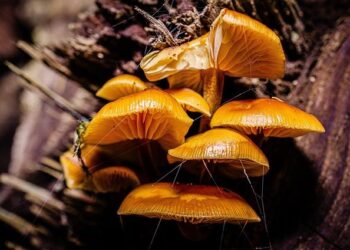This article was produced by National Geographic Traveller (UK).
The seals aren’t interested in me. Blinking slowly in the waters of the Atlantic, they look in my direction for just a moment before descending beneath the wash. As they slip silently from view, I look around my one-person kayak for further signs of life. Today, though, is a bleak one, the sky a smudged grey, the water steely. It’s easy to imagine I’m alone out here.
Sea kayaking in Scotland means taking your chances with the weather. You could get sunny skies and sparkling waters, or you could get incessant raindrops falling heavily around you as if trying to drench you entirely. I’ve landed on the latter. As I paddle from Lamlash, on the Isle of Arran, to Holy Isle, just offshore, my guide Andy McNamara, from local adventure outfitter Otter’s Tail, assures me this won’t last. Indeed, the rain soon ceases and the sky lightens.
(How to plan the ultimate island-hopping adventure in Scotland.)
But I barely notice. I’m so determined to make it across the mile-long stretch of water, all I pay heed to is Andy telling me to “keep heading for the ‘wee Donald’”. I repeatedly plunge my paddle into the water, eyes trained to the white lighthouse standing at the southern end of Holy Isle — a low-slung, enticing triangle on the horizon, which grows closer and bigger as we push forward.
We’re heading into the wind, adrift in the Atlantic, and it’s hard work. Because of the chilly weather, my hands are encased in pogies (mittens with a hole for the oar handle), keeping them attached to the paddle — and keeping me moving ever forwards. This constant, almost-religious focus is one of the joys of sea kayaking. It’s also a fitting way to get to the Holy Isle, I muse, as we reach the lee of the land.
This tiny island, measuring just 2sq miles, has a mystical heritage that stretches back to the sixth century. Saint Molaise, son of an Irish king, came here to live as a hermit instead of taking up his father’s mantle, sleeping for years inside a cave that can still be visited. Today, Holy Isle is home to the Centre for World Peace and Health, a temple directed by a Tibetan Buddhist lama, offering retreats and workshops.
The wind drops and I stagger to my feet on the beach. It’s easy to see why Holy Isle has attracted people for so long: even the greyest day here comes with colour, the heather, bracken and grass that back the beach forming a palette of warm browns and lush greens. Moss-covered trees cling to vertiginous slopes that reach from the coastline to the island’s highest point, the 1,030ft-high Mullach Mòr. Here and there, granite boulders poke through the grass, providing obstacles to leap over as Andy and I walk away from the beach.
To avoid stumbling, I focus on my feet, which means I don’t spot the island’s wildlife until it’s right in front of me — two Saanen goats, with huge, curled horns and beards, appear on the path in front of us.
“There are mink and otters here, too,” says Andy, as we watch the goats scramble off across the rocks towards the sea. “If you spot something down on the beach looking at you, and it keeps staring, it’s likely a mink.”

The Lamlash Bay No Take Zone, established in 2008, means all fishing within a triangle of water between Arran and Holy Isle is now prohibited.
Photograph by David Chapman, Alamy
The wildlife here might be bold, but it has reason to be. The golden rules of Holy Isle, laid down by the Centre for World Peace and Health, include respecting all life. The next morning, I find a similar spirit on Arran as I visit the Community of Arran Seabed Trust (COAST) Discovery Centre, a 15-minute walk south along the coast from Lamlash. It tells the story of COAST, an initiative set up in 1995 by two local divers who had noticed a decline in the state of the seabed and its native species and wanted to reverse the changes. Thanks to their efforts, the Lamlash Bay No Take Zone was established in 2008, meaning all fishing is now prohibited in a triangle of water between Arran and Holy Isle. The scallop and lobster population has boomed, and Arran is now moving on to bigger things, like a bid for UNESCO Global Geopark status. Should it be successful, the plan is for increased waymarked trails and improved signage around the island.
On my last morning here, I meet Kate Sampson, a senior ranger with the National Trust for Scotland, for a walk in Glen Rosa, a 15-minute drive north from Lamlash. We chat as we walk through the glacier-carved valley, discussing the route I took to get here — the Caledonian Sleeper to Glasgow, then a hire car and ferry to Arran. She explains the Trust has fenced off a large area of the glen from deer and is now planting thousands of native trees, from sessile oak to hazel and willow, to replace those lost to overgrazing and to help increase biodiversity.
“Change happens,” Kate says as she lists off species reappearing here, including the puss moth caterpillar and the buttercup-like globeflower. Then, she invites me to be part of it, planting a tree in the centre of the glen. “This is one of the rarest in the world,” she tells me, handing me an Arran whitebeam, endemic to the island. Gingerly, I grasp its tiny roots and push them into the earth. Patting down the damp soil, Arran literally getting under my fingernails, I feel connected to the island in a new way. I leave knowing my own tree is now taking root here, much like the change these islanders are working for.
Four more Scottish isles to visit
1. Skye
Dramatic mountains, some of Scotland’s leading restaurants and ease of access from the mainland via a road bridge combine to make Skye a wildly popular destination. It’s best to avoid peak season and visit in spring or autumn, for hikes to the Old Man of Storr basalt outcrop and along the water’s edge at the Fairy Pools. Don’t miss dinner at The Three Chimneys, a much-loved lochside restaurant that’s been showing off the island’s fresh produce since 1985.
2. Mull
The second-largest island in the Inner Hebrides, Mull is just 45 minutes by ferry from Oban on the mainland. Spend some time here exploring the colourful town of Tobermory and remote sandy beaches. Mull is also the jumping-off point for trips to neighbouring Iona’s historic abbey and to uninhabited Staffa, home to the organ-pipe basalt columns of Fingal’s Cave.
3. Shetland Mainland
Closer to Norway than to Edinburgh, Shetland is an independent-spirited archipelago. Low-lying and craggy, its main island, Mainland, culminates in jaw-dropping cliffs wheeling with seabirds and views to confuse — is that land part of the same mass or is that yet another island? Make time to visit Jarlshof — an archaeological site incorporating prehistoric and Norse settlements — and the sandy isthmus of St Ninian’s beach, as well as Lerwick’s pubs for live folk music.
4. Islay
Every whisky-lover will know Islay for its peaty, smoky single malts, and you won’t get far on Scotland’s fifth-largest island without encountering the tell-tale chimney of a distillery. There are 10 in total, some scattered around Port Ellen and others dotted across the island’s low-slung, wind-whipped moorland.
How to do it:
Otter’s Tail has full-day sea kayaking trips for £120pp, leaving from Lamlash. McKinlay Kidd has seven-night self-drive Arran, Islay and Kintyre tours from £1,905 per person.
Published in the June 2024 issue of National Geographic Traveller (UK).
To subscribe to National Geographic Traveller (UK) magazine click here. (Available in select countries only).
>>> Read full article>>>
Copyright for syndicated content belongs to the linked Source : National Geographic – https://www.nationalgeographic.com/travel/article/isle-of-arran-scotland-wildlife-kayak






























